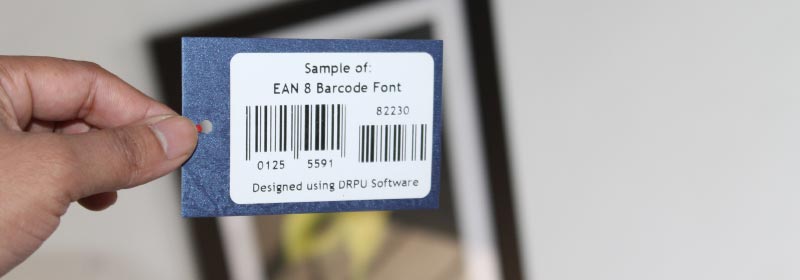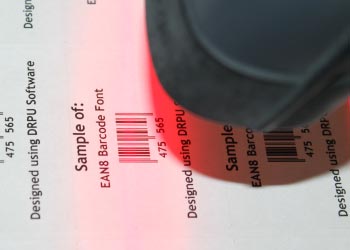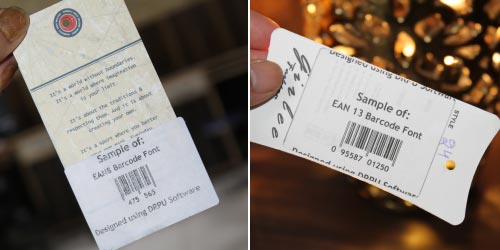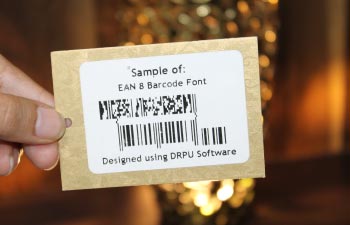Advantages Of Using EAN8 Barcode
The EAN-8 barcode is a popular type of barcode used to encode product information, such as a product's unique identification number. EAN-8 barcodes offer a number of advantages over other types of barcodes, including increased efficiency, accuracy, and flexibility. In this article, we will discuss some of the key advantages of using EAN-8 barcodes.
-
Efficiency
One of the main advantages of using EAN-8 barcodes is increased efficiency in product identification and tracking. By encoding product information in a barcode, businesses can accurately process large numbers of products, reducing the time and labor required for manual identification. This increased efficiency can be particularly valuable in app such as retail checkot the ability to quickly scan and process large numbers of products can reduce checkout times and improve customer satisfaction.
-
Cost-Effective
EAN-8 barcodes are a cost-effective technology, offering a low-cost solution for product identification and tracking. Compared to other technologies such as RFID, EAN-8 barcodes are significantly cheaper to implement and maintain, making them an attractive option for businesses of all sizes.This cost-effectiveness can be particularly valuable in applications such as small business operations, where businesses may not have the resources to invest in more expensive technologies.
-
Flexibility
EAN-8 barcodes offer a high degree of flexibility in terms of the information that can be encoded. This flexibility allows businesses to encode a wide range of information in the barcode, including product identification numbers, batch numbers, and expiration dates. This flexibility can be particularly valuable in applications such as supply chain management, where businesses need to track a wide range of product information to ensure timely and efficient delivery of products.
-
Compatibility
EAN-8 barcodes are widely recognized and accepted in the global marketplace, making them a highly compatible and interoperable technology. This compatibility allows businesses to use EAN-8 barcodes in a wide range of applications and with a wide range of equipment and software. This compatibility can be particularly valuable in applications such as international trade, where businesses need to be able to identify and track products across different countries and regions.
-
Accuracy
Another advantage of using EAN-8 barcodes is increased accuracy in product identification and tracking. By encoding product information in a barcode, businesses can reduce the risk of errors and inaccuracies that can result from manual identification and tracking. This increased accuracy can be particularly valuable in applications such as inventory management, where accurate tracking of product quantities and locations is critical to the success of the business.
In conclusion, EAN-8 barcodes offer a number of advantages over other types of barcodes, including increased efficiency, accuracy, flexibility, compatibility, and cost-effectiveness.
Structure Of EAN8 Barcode System
The structure of an EAN-8 barcode consists of a series of bars and spaces that encode eight digits of information. These digits are divided into two parts, with the first four digits being encoded on the left-hand side of the barcode and the last four digits being encoded on the right-hand side of the barcode. In addition to the encoded digits, the barcode also includes several other elements, such as a quiet zone, a start character, and a checksum digit.

The bars and spaces in an EAN-8 barcode are arranged in a specific pattern that corresponds to the digits being encoded. Each digit is encoded using a pattern of four bars and three spaces, with each bar and space being a specific width. The width of each bar and space is determined by the encoding system used in the barcode, which is known as the "2 of 5 interleaved" system. This system uses two widths of bars and spaces, with one width representing a "narrow" bar or space and the other representing a "wide" bar or space. The pattern of bars and spaces for each digit is unique and is determined by a set of rules known as the "parity rules." These rules ensure that the barcode is encoded correctly and can be read accurately by barcode scanners.
The EAN-8 barcode is divided into two parts, with the first four digits being encoded on the left-hand side of the barcode and the last four digits being encoded on the right-hand side of the barcode. The left-hand side of the barcode includes a quiet zone, which is a blank area that surrounds the barcode and helps to reduce interference from other markings or patterns. The left-hand side also includes a start character, which is a specific pattern of bars and spaces that indicates the beginning of the barcode. The right-hand side of the barcode does not include a quiet zone, but it does include a checksum digit. The checksum digit is calculated using a specific algorithm and is used to ensure that the barcode is encoded correctly and can be read accurately by barcode scanners.
The quiet zone is a blank area that surrounds the barcode on all sides. This area is typically about 9 times the width of the narrowest bar or space in the barcode. The quiet zone is important because it helps to reduce interference from other markings or patterns that may be present near the barcode. This interference can cause errors in the barcode scanning process, which can result in incorrect data being recorded.
The start character is a specific pattern of bars and spaces that indicates the beginning of the barcode. The start character is always the same pattern for all EAN-8 barcodes and is represented by the pattern "101." The start character is important because it helps barcode scanners to locate the beginning of the barcode and to read the data correctly. Without the start character, the barcode scanner may not be able to accurately read the data encoded in the barcode.
The checksum digit is a single digit that is added to the barcode to ensure that it is encoded correctly and can be read accurately by barcode scanners. The checksum digit is calculated using a specific algorithm, which takes into account the values of the other digits in the barcode. The checksum digit is important because it helps to reduce the likelihood of errors in the barcode scanning process. If the barcode scanner detects an error in the checksum digit, it will reject the barcode and prompt the user to re-scan the item.
Conclusion: The structure of an EAN-8 barcode consists of a series of bars and spaces that encode eight digits of information. The barcode is divided into two parts, with the first four digits being encoded on the left-hand side of the barcode and the last four digits being encoded on the right-hand side of the barcode.
How is EAN8 barcode read and decoded
The EAN-8 barcode is a popular type of barcode used to encode product information, such as a product's unique identification number. Barcodes are read and decoded using barcode scanners, which use specialized hardware and software to capture and interpret the information encoded in the barcode. In this article, we will discuss how EAN-8 barcodes are read and decoded, and the different types of barcode scanners used for this purpose.
➔ The Basics of EAN-8 BarcodesAn EAN-8 barcode consists of a series of bars and spaces of varying widths, which are arranged in a specific pattern to encode information. The barcode is read by a barcode scanner, which shines a light on the barcode and measures the reflection of the light to detect the pattern of bars and spaces.Each bar or space in the barcode is either black or white, and represents a binary digit, or bit. The pattern of bits in the barcode represents the information encoded in the barcode, such as the product identification number and checksum digit.
➔ Barcode Scanners
There are several types of barcode scanners used to read and decode EAN-8 barcodes. These include handheld scanners, fixed-mount scanners, and mobile devices with built-in scanners.
A. Handheld scanners Handheld scanners are the most common type of barcode scanner, and are used in a wide range of applications, from retail checkout to inventory management. Handheld scanners typically consist of a handle with a trigger button, a light source, and a sensor to detect the reflection of the light from the barcode.
B. Fixed-mount scanners Fixed-mount scanners are used in applications where a barcode must be read automatically, without human intervention. These scanners are typically installed in a fixed location, such as a conveyor belt, and use sensors to detect the presence of a barcode and automatically read and decode it.
C. Mobile devices Mobile devices with built-in scanners, such as smartphones and tablets, are increasingly popular for mobile point-of-sale and inventory management applications. These devices use the built-in camera to capture an image of the barcode, which is then processed using software to decode the information.
➔ Decoding EAN-8 BarcodesTo decode an EAN-8 barcode, the barcode scanner must first detect the barcode and capture an image of the pattern of bars and spaces. The scanner then uses specialized software to interpret the pattern of bars and spaces and decode the information encoded in the barcode.
The decoding process typically involves several steps, including:
-
Start Character Detection:
The barcode scanner begins by looking for the start character, which is a unique pattern of bars and spaces that indicates the beginning of the barcode.
-
Character Recognition:
Once the start character is detected, the scanner begins to read the pattern of bars and spaces that follows. Each character in the barcode is represented by a specific pattern of bars and spaces, which the scanner must recognize and interpret.
-
Checksum Calculation:
After all of the characters in the barcode have been read and recognized, the scanner calculates a checksum digit to verify the accuracy of the barcode. The checksum digit is calculated using a specific algorithm, which takes into account the other digits in the barcode.
-
Validation:
Finally, the scanner validates the barcode by checking the checksum digit against the calculated value. If the checksum digit matches, the barcode is considered valid, and the information encoded in the barcode is extracted and passed on to the system or application using the barcode.
In conclusion, EAN-8 barcodes are read and decoded using specialized hardware and software, such as handheld scanners, fixed-mount scanners, and mobile devices with built-in scanners. The decoding process involves several steps, including start character detection, character recognition, checksum calculation, and validation. By using barcode scanners to read and decode EAN-8 barcodes, businesses and organizations can improve efficiency and accuracy in a wide range of applications, from retail checkout to inventory management.
Download and Install Barcode Label Maker
The EAN-8 barcode is a type of barcode that is used to encode product information, such as a product's unique identification number. The barcode is made up of a series of bars and spaces that encode the information in a specific format. The characters that can be encoded in an EAN-8 barcode are limited to numeric digits, which are used to represent the product identification number and a checksum digit.
| Encoded EAN8 Barcode System | |
| Numeric Digits: | The EAN-8 barcode is limited to encoding numeric digits, which are the digits 0 through 9. This means that only numbers can be encoded in the barcode, and no letters or other characters can be used. |
| Product Identification Number: | The primary purpose of the EAN-8 barcode is to encode the product identification number, which is a unique number assigned to each product. The product identification number is typically assigned by the manufacturer, and is used to track the product through the supply chain and retail channels.The product identification number can be any combination of up to 7 numeric digits. The number must be unique for each product, and must be assigned in a consistent and systematic way to ensure that products can be easily identified and tracked. |
| Checksum Digit: | In addition to the product identification number, the EAN-8 barcode also includes a checksum digit, which is used to ensure the accuracy of the barcode. The checksum digit is calculated based on the other digits in the barcode, and is used to detect errors in the encoding or reading of the barcode. The checksum digit is a single numeric digit, which is calculated using a specific algorithm. The algorithm takes the other 7 digits of the barcode, and calculates a value that is used to determine the checksum digit. |
| Implications of Numeric Encoding: | The use of numeric encoding in the EAN-8 barcode has several implications for product identification and tracking. Because the barcode is limited to numeric digits, it is important for manufacturers and retailers to carefully manage the use of these digits to ensure that each product is uniquely identified.One common practice is to assign a unique identification number to each product, and to use the remaining digits of the barcode to encode other information, such as the manufacturer's identification number, the product's weight, or other relevant data. |
In addition, the use of numeric encoding can also impact the readability of the barcode. Because the barcode is limited to numeric digits, the bars and spaces must be tightly packed to ensure that the barcode fits within a reasonable size. This can make the barcode more difficult to read accurately, especially if the barcode is damaged or poorly printed.
To address this issue, many barcode scanners and software programs are designed to be highly sensitive and accurate, to ensure that even poorly printed or damaged barcodes can be read with a high degree of accuracy.
Conclusion: The characters that can be encoded in an EAN-8 barcode are limited to numeric digits, which are used to represent the product identification number and a checksum digit. The use of numeric encoding has several implications for product identification and tracking, including the need for careful management of the use of digits to ensure that products are uniquely identified, and the potential impact on barcode readability. While the use of numeric encoding can pose challenges, many barcode scanners and software programs are designed to be highly sensitive and accurate to ensure that even poorly printed or damaged barcodes can be read with a high degree of accuracy.
EAN8 Barcode Different From Other Barcode Types

It is a subset of the EAN-13 barcode, which encodes 13 digits. The EAN-8 barcode is often used for smaller products, where the full EAN-13 barcode would take up too much space.
EAN-8 barcodes are unique in several ways, including their size, structure, and encoding. In this article, we will discuss the differences between EAN-8 barcodes and other barcode types in detail.
Size: One of the most obvious differences between EAN-8 barcodes and other barcode types is their size. EAN-8 barcodes are smaller than other barcode types, including the EAN-13, UPC-A, and UPC-E barcodes.
The EAN-8 barcode is made up of eight digits, which are encoded using bars and spaces of varying widths. The barcode itself is typically about 2.2 inches wide and 1 inch tall, which makes it small enough to fit on smaller products, such as candy bars or small toys.
Structure:The structure of the EAN-8 barcode is also different from other barcode types. The barcode is divided into two parts: the left-hand side and the right-hand side. The left-hand side contains the first four digits of the barcode, while the right-hand side contains the last four digits.
The left-hand side of the barcode also contains a quiet zone, which is a blank space that surrounds the barcode. This quiet zone helps the barcode scanner read the barcode more accurately, as it reduces the risk of interference from other markings or patterns.
Encoding:Another difference between EAN-8 barcodes and other barcode types is the way they are encoded. EAN-8 barcodes use a system of bars and spaces to encode the eight digits of the barcode.
Each digit is encoded using a series of four bars and three spaces. The bars and spaces are of varying widths, with each digit having a unique pattern of bars and spaces. The barcode scanner reads these patterns of bars and spaces and translates them into the corresponding digits.
